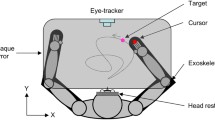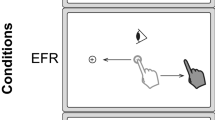Abstract
The smooth pursuit eye movement system appears to be importantly engaged during the planning and execution of interceptive hand movements. The present study sought to probe the interaction between eye and hand control systems by examining their responses during an interception task that included target speed perturbations. On 2/3 of trials, the target increased or decreased speed at various times, ranging from about 300 ms before to 150 ms after the onset of a finger movement directed to intercept the target and was triggered by a GO signal. Additionally, the same 2D sum-of-sines target trajectories were followed with the eyes without interception. The smooth pursuit system responded more quickly if the target speed perturbation occurred earlier during the reaction time (i.e., near the time of the GO signal). Similarly, the finger movement began more quickly if target speed was increased earlier during the reaction time. For early perturbation conditions, the initial direction of the finger movement matched the predicted target intercept using the new target speed. For perturbations occurring after finger movement, onset initial direction of finger movement did not match target interception such that the finger path began to curve toward the perturbed target after about 150–200 ms. The results support the idea of an active process of visual target path extrapolation simultaneously used to guide both the eye and hand.






Similar content being viewed by others
References
Barnes GR, Marsden JF (2002) Anticipatory control of hand and eye movements in humans during oculo-manual tracking. J Physiol 539:317–330
Batista AP, Buneo CA, Snyder LH, Andersen RA (1999) Reach plans in eye-centered coordinates. Science 285:257–260
Bell AH, Meredith MA, Van Opstal AJ, Munoz DP (2006) Stimulus intensity modifies saccadic reaction time and visual response latency in the superior colliculus. Exp Brain Res 174:51–59
Brenner E, Smeets JBJ (1997) Fast responses of the human hand to change in target position. J Mot Behav 29:297–310
Brenner E, Smeets JBJ, de Lussanet MHE (1998) Hitting moving targets continuous control of the acceleration of the hand on the basis of the target’s velocity. Exp Brain Res 122:467–474
Brouwer AM, Brenner E, Smeets JB (2002) Hitting moving objects: is target speed used in guiding the hand? Exp Brain Res 143:198–211
Buneo CA, Jarvis MR, Batista AP, Andersen RA (2002) Direct visuomotor transformations for reaching. Nature 416:632–636
Carnahan H, McFadyan BJ (1996) Visuomotor control when reaching toward and grasping moving targets. Acta Psychol 92:17–32
Carreiro LRR, Haddad H, Baldo MVC (2011) Effects of intensity and positional predictability of a visual stimulus on simple reaction time. Neurosci Lett 487:345–349
Churchland M, Lisberger SG (2001) Experimental and computational analysis of monkey smooth pursuit eye movements. J Neurophysiol 86:741–759
Duhamel JR, Bremmer F, BenHamed S, Graf W (1997) Spatial invariance of visual receptive fields in parietal cortex neurons. Nature 389:845–848
Eggert T, Rivas F, Straube A (2005) Predictive strategies in interception tasks: differences between eye and hand movements. Exp Brain Res 160:433–449
Engel KC, Soechting JF (2003) Interactions between ocular motor and manual responses during two-dimensional tracking. Prog Brain Res 142:141–153
Engel KC, Anderson JH, Soechting JF (1999) Oculomotor tracking in two dimensions. J Neurophysiol 81:1597–1602
Engel KC, Anderson JH, Soechting JF (2000) Similarity in the response of smooth pursuit and manual tracking to a change in the direction of target motion. J Neurophysiol 84:1149–1156
Fu QG, Flament D, Coltz JD, Ebner TJ (1997) Relationship of cerebellar Purkinji cell simple spike discharge to movement kinematics in the monkey. J Neurophysiol 78:478–491
Gauthier GM, Hofferer JM (1976) Eye tracking of self-moved targets in the absence of vision. Exp Brain Res 26:121–139
Gauthier GM, Vercher JL, Mussa Ivaldi F, Marchetti E (1988) Oculo-manual tracking of visual target: control learning, coordination control and coordination model. Exp Brain Res 73:127–137
Georgopoulos AP, Kalaska JF, Massey JT (1981) Spatial trajectories and reaction times of aimed movements: effects of practice, uncertainty, and change in target location. J Neurophysiol 46:725–743
Gielen CC, Dijkstra TM, Roozen IJ, Welten J (2009) Coordination of gaze and hand movements for tracking and tracing in 3D. Cortex 45:340–355
Henriques DY, Crawford JD (2002) Role of eye, head, and shoulder geometry in the planning of accurate arm movements. J Neurophysiol 87:1677–1685
Jaskowski P, Sobieralska K (2004) Effect of stimulus intensity on manual and saccadic reaction time. Percept Psychophys 66:535–544
Kim JN, Shadlen MN (1999) Neural correlates of a decision in the dorsolateral prefrontal cortex of the macaque. Nat Neurosci 2:176–185
Koken PW, Erkelens CJ (1992) Influences of hand movements on eye movements in tracking tasks in man. Exp Brain Res 88:657–664
Lacquaniti F, Terzuolo C, Viviani P (1983) The law relating the kinematic and figural aspects of drawing movements. Acta Psychol 54:115–130
Lakhani B, Vette AH, Mansfield A, Miyasike-daSilva V, McIlroy WE (2012) Electrophysiological correlates of changes in reaction time based on stimulus intensity. PLoS ONE 7(5):e36407
Leung HC, Kettner RE (1997) Predictive smooth pursuit of complex two-dimensional trajectories demonstrated by perturbation responses in monkeys. Vision Res 37:1347–1354
Leung HC, Suh M, Kettner RE (2000) Cerebellar flocculus and paraflocculus Purkinji cell activity during circular pursuit in monkey. J Neurophysiol 83:13–30
Merchant H, Battaglia-Mayer A, Georgopoulos AP (2003) Interception of real and apparent motion targets: psychophysics in humans and monkeys. Exp Brain Res 152:106–112
Mrotek LA, Soechting JF (2007) Target interception: hand-eye coordination and strategies. J Neurosci 27:7297–7309
Mrotek LA, Flanders M, Soechting JF (2006) Oculomotor responses to gradual changes in target direction. Exp Brain Res 172:175–192
Port NL, Lee D, Dassonville P, Georgopoulos AP (1997) Manual interception of moving targets. I. Performance and movement initiation. Exp Brain Res 116:406–420
Prablanc C, Martin O (1992) Automatic control during hand reaching at undetected two-dimensional target displacements. J Neurophysiol 67:455–469
Savelsbergh GJP, Whiting HTA, Burden AM, Bartlett RM (1992) The role of predictive visual temporal information in the coordination of muscle activity in catching. Exp Brain Res 89:223–228
Schwartz JD, Lisberger SG (1994) Initial tracking conditions modulate the gain of visuo-motor transmission for smooth pursuit eye movements in monkeys. Vis Neurosci 11:411–424
Shadlen MN, Newsome WT (1996) Motion perception: seeing and deciding. Proc Natl Acad Sci USA 93:628–633
Smeets JBJ, Brenner E (1995) Perception and action are based on the same visual information: distinction between position and velocity. J Exp Psychol Hum Percept Perform 21:19–31
Soechting JF, Juveli JZ, Rao HM (2009) Models for the extrapolation of target motion for manual interception. J Neurophysiol 102:1491–1502
Soechting JF, Rao HM, Juveli JZ (2010) Incorporating prediction in models for two-dimensional smooth pursuit. PLoS ONE 5:e12574
Tanaka H, Sejnowski TJ, Krakauer JW (2009) Adaptation to visuomotor rotation through interaction between posterior parietal and motor cortical areas. J Neurophysiol 102:2921–2932
van Donkelaar P, Lee RG, Gellman RS (1992) Control strategies in directing the hand to moving targets. Exp Brain Res 91:151–161
van Donkelaar P, Fisher C, Lee RG (1994) Adaptive modification of oculomotor pursuit influences manual tracking responses. NeuroReport 5:2233–2236
van Sonderen JF, Denier van der Gon JJ, Gielen CCAM (1988) Conditions determining early modification of motor programmes in response to changes in target location. Exp Brain Res 71:320–328
van Sonderen JF, Gielen CC, Denier van der Gon JJ (1989) Motor programmes for goal-directed movements are continuously adjusted according to changes in target location. Exp Brain Res 78:139–146
Veerman MM, Brenner E, Smeets JBJ (2008) The latency for correcting a movement depends on the visual attribute that defines the target. Exp Brain Res 187:219–228
Acknowledgments
The author would like to thank John Soechting, Martha Flanders, and Jan Hondzinski for helpful suggestions on previous drafts of this manuscript. The suggestions made by three anonymous reviewers were also extremely beneficial. This work was supported by the National Institute of Neurological Disorders and Stroke: NS15018.
Author information
Authors and Affiliations
Corresponding author
Rights and permissions
About this article
Cite this article
Mrotek, L.A. Following and intercepting scribbles: interactions between eye and hand control. Exp Brain Res 227, 161–174 (2013). https://doi.org/10.1007/s00221-013-3496-2
Received:
Accepted:
Published:
Issue Date:
DOI: https://doi.org/10.1007/s00221-013-3496-2




